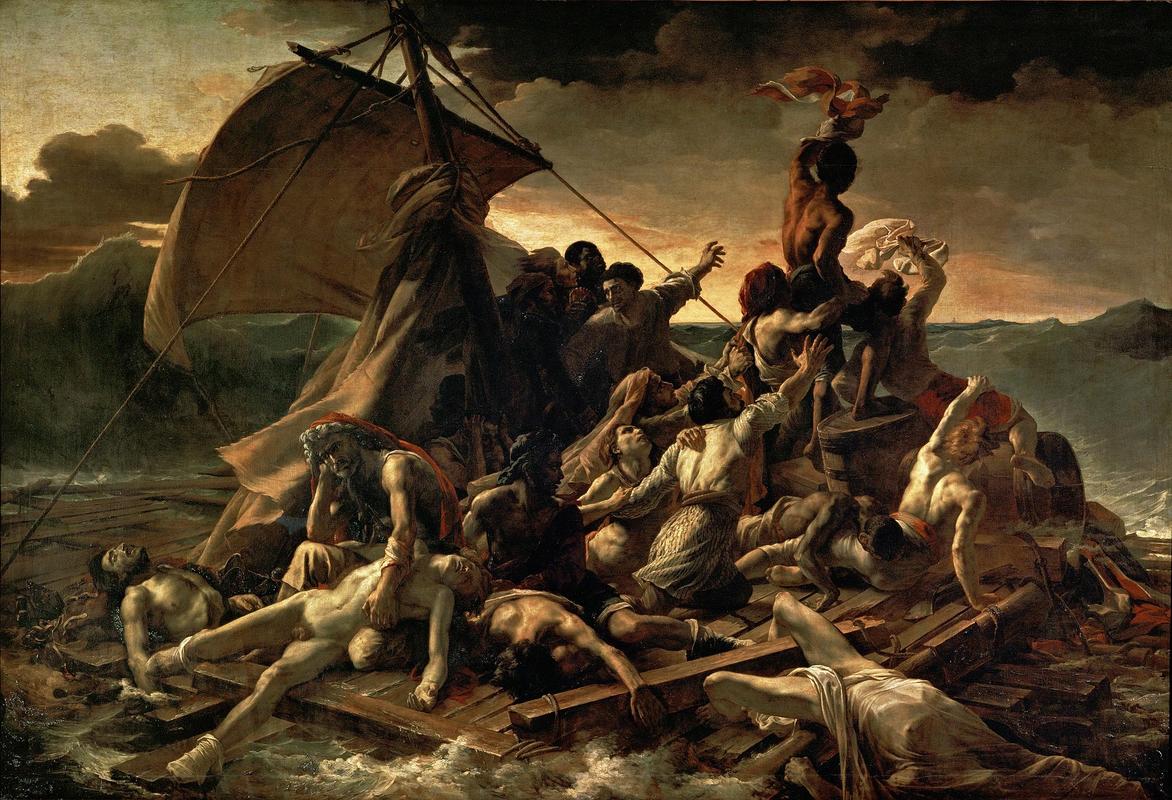More about The Raft of the Medusa
- All
- Info
- Shop

Sr. Contributor
The story behind Raft of the Medusa is full of determination in the face of incredible odds, showing how the human spirit can overcome any obstacle with just the right amount of cannibalism.
The French naval vessel Medusa ran aground a sandbank en route to retake Senegal from Britain. With too few lifeboats, 150 crew members built a raft and went adrift for 13 days. Only 15 of the crew survived the ordeal. Upon return to France, the survivors were forced to sign an affidavit recusing the incompetent captain (and crown) from responsibility. Two refused and authored a book recounting their experiences. Murder and suicide were rampant across the raft, with a single melee taking more than 60 lives in the first few days. With only soggy biscuits and wine onboard, some of the crew got drunk and went about hacking away at the craft to sink it (YOLO). Others decided a nice preparation of human jerky sounded just right. One of the authors admitted to scooping out "brown and purple" human flesh from a dead mate. He hung it to dry in the sun for flavor. The book became a bestseller which the state sought to censor. Other anecdotes include how the author personally threw weaker crew members over to conserve the small cache of wine and, once that ran out, washed the sun-dried manflesh down with urine. Makes us think The Walking Dead prequel could have used some inspiration from the French Romantics.
Rough segue, speculation persists that the interest in such morose subject matter arose from a failed relationship between Gericault and his reportedly hot aunt. The two had a kid, whom Gericault never met. At least Gericault decided to paint the stark subject matter with the respect and humanity it deserved. In addition to making a model of the raft with wax figures, he frequented morgues and dying folks in hospital to better understand human decomposition. The painter brought so many cadavers and severed body parts to his studio that his friends referred to it as the 'charnel house.' And his friends would know, considering they were often the models for the poor unfortunate souls writhing about the raft in the final painting.
Gericault produced more than one hundred figure sketches to prepare for this work. Two of those sketches are on display in the Louvre. The painting established Gericault's fame, but it never sold. One art critic at the time wrote, "This painting is too sad, there are too many dead people. Couldn't he have painted a more cheerful shipwreck?" He eventually made money for the short remainder of his life (which was ended at 32 by tuberculosis) by touring the Raft of the Medusa in London and Dublin. The British crowds flocked to see a crowning moment of French embarrassment.
Featured Content
Here is what Wikipedia says about The Raft of the Medusa
The Raft of the Medusa (French: Le Radeau de la Méduse [lə ʁado d(ə) la medyz]) – originally titled Scène de Naufrage (Shipwreck Scene) – is an oil painting of 1818–1819 by the French Romantic painter and lithographer Théodore Géricault (1791–1824). Completed when the artist was 27, the work has become an icon of French Romanticism. At 491 by 716 cm (16 ft 1 in by 23 ft 6 in), it is an over-life-size painting that depicts a moment from the aftermath of the wreck of the French naval frigate Méduse, which ran aground off the coast of today's Mauritania on 2 July 1816. On 5 July 1816, at least 150 people were set adrift on a hurriedly constructed raft; all but 15 died in the 13 days before their rescue, and those who survived endured starvation and dehydration and practiced cannibalism. The event became an international scandal, in part because its cause was widely attributed to the incompetence of the French captain. Géricault chose this large-scale uncommissioned work to launch his career, using a subject that had already generated widespread public interest. The event fascinated him.
Théodore Géricault's social circles had close family connections with the French navy and were directly involved in France's colonies and France's slave trade. Indeed, one of these relations, a naval officer and a slave owner, died defending France's colonial interests on the coast of west Africa in 1779 not far from the site of the Méduse shipwreck decades later.
Before Géricault began work on the final painting, he undertook extensive research and produced many preparatory sketches. He interviewed two of the survivors and constructed a detailed scale model of the raft. He visited hospitals and morgues where he could view, first-hand, the colour and texture of the flesh of the dying and dead. As he had anticipated, the painting proved highly controversial at its first appearance in the Salon of 1819, attracting passionate praise and condemnation in equal measure. However, it established his international reputation and today is widely seen as seminal in the early history of the Romantic movement in French painting.
Although The Raft of the Medusa retains elements of the traditions of history painting, in both its choice of subject matter and its dramatic presentation, it represents a break from the calm and order of the prevailing Neoclassical school. Géricault's work attracted wide attention from its first showing and was then exhibited in London. The Louvre acquired it soon after the artist's death at the age of 32. The painting's influence can be seen in the works of Eugène Delacroix, J. M. W. Turner, Gustave Courbet, and Édouard Manet.
Check out the full Wikipedia article about The Raft of the Medusa
















